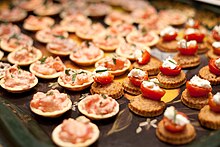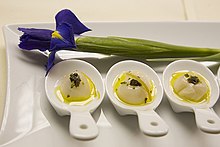Hors d'oeuvre




With hors d'oeuvre ( French. [ Ɔʁdœvʁ ] , "out of work") is known in classical French cuisine a kind of appetizer . They are usually very small portions and can be served cold or warm.
Today's practice is to serve hors d'oeuvre before starting a meal. The purpose is to whet your appetite or to bridge the waiting time before the actual meal begins. It can be served both at the table and to standing guests. It usually consists of canapé , crustade or the like. Basically, they are outside of the actual menu - their composition does not affect the structure of the menu.
Synonyms for Horsd'œuvre are: Antipasto , Appetithäppchen , Appetizer , Amuse-Gueule . In the classic kitchen, however, the term is also used for the starter per se. Horsd'œuvre froid describes the cold starters, Horsd'œuvre chaud the warm ones.
Kitchen history
The way of serving a menu in several courses in succession, which is common in the western world today, is comparatively new. It did not gradually become common until the 19th century. The Russian Prince Kurakin is said to have had a banquet served in this way for the first time in Paris in 1830. It is referred to as so-called service à la russe ("service the Russian way"). The service à la française ("French style service"), which developed from the food culture of the Middle Ages and the Renaissance, is historically older . It is a menu in which several very different dishes are on the table at the same time for each of two or three courses.
There were also intermediate dishes on the table, the so-called entrées. This meant dishes such as ragouts of veal cheeks or tongue, dishes with poultry meat or sweetbreads and pies. It was common for a dessert such as a cake to be on the table in addition to fruit plates. Between the dishes stood candles, salt, flower arrangements and decorative elements. This was supplemented by the so-called "small dishes", the hors d'oeuvre, which were spatially separated from the other dishes in the outer area of the table. It was usually small patties, pickled fish, eggs, artichokes, radishes, and the like. Hors d'oeuvre literally stood outside the actual meal and were traditionally also the smallest dishes on the table.
In the course of the 19th century a gradual change to service à la Russian began and as part of this change, the hors d'oeuvre moved to the beginning of a meal and was served before the soup.
literature
- Dan Jurafsky: The Language of Food: A Linguist Reads the Menu. WW Norton & Company, New York 2014, ISBN 978-0-393-24587-5 .
- Margaret Visser: The Rituals of Dinner: The Origins, Evolution, Eccentricities, and Menaning of Table Manners. Penguin Books, New York, 1991, ISBN 0-14-017079-0 .
Web links
Single receipts
- ^ Visser: The Rituals of Dinner: The Origins, Evolution, Eccentricities, and Menaning of Table Manners . P. 198.
- ^ Visser: The Rituals of Dinner: The Origins, Evolution, Eccentricities, and Menaning of Table Manners . P. 202.
- ^ Visser: The Rituals of Dinner: The Origins, Evolution, Eccentricities, and Menaning of Table Manners . P. 199.
- ^ Jurafsky: The Language of Food: A Linguist Reads the Menu. P. 25.
- ^ Jurafsky: The Language of Food: A Linguist Reads the Menu. P. 26.